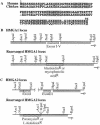Construction and analysis of cells lacking the HMGA gene family
- PMID: 12930952
- PMCID: PMC212792
- DOI: 10.1093/nar/gkg684
Construction and analysis of cells lacking the HMGA gene family
Abstract
The high mobility group A (HMGA) family of non-histone chromosomal proteins is encoded by two related genes, HMGA1 and HMGA2. HMGA proteins are architectural transcription factors that have been found to regulate the transcription of a large number of genes. They are also some of the most commonly dysregulated genes in human neoplasias, highlighting a role in growth control. HMGA1 and HMGA2 have also been found to stimulate retroviral integration in vitro. In this study, we have cloned chicken HMGA1, and used the chicken DT40 B-cell lymphoma line to generate cells lacking HMGA1, HMGA2 and both in combination. We tested these lines for effects on cellular growth, gene control and retroviral integration. Surprisingly, we found that the HMGA gene family is dispensable for growth in DT40 cells, and that there is no apparent defect in retroviral integration in the absence of HMGA1 or HMGA2. We also analyzed the activity of approximately 4000 chicken genes, but found no significant changes. We conclude that HMGA proteins are not strictly required for growth control or retroviral integration in DT40 cells and may well be redundant with other factors.
Figures






Similar articles
-
The HMGA proteins: a myriad of functions (Review).Int J Oncol. 2008 Feb;32(2):289-305. Int J Oncol. 2008. PMID: 18202751 Review.
-
HMGA1 and HMGA2 protein expression in mouse spermatogenesis.Oncogene. 2002 May 16;21(22):3644-50. doi: 10.1038/sj.onc.1205501. Oncogene. 2002. PMID: 12032866
-
Downregulation of HMGA-targeting microRNAs has a critical role in human pituitary tumorigenesis.Oncogene. 2012 Aug 23;31(34):3857-65. doi: 10.1038/onc.2011.557. Epub 2011 Dec 5. Oncogene. 2012. PMID: 22139073
-
Macroscopic differences in HMGA oncoproteins post-translational modifications: C-terminal phosphorylation of HMGA2 affects its DNA binding properties.J Proteome Res. 2009 Jun;8(6):2978-89. doi: 10.1021/pr900087r. J Proteome Res. 2009. PMID: 19317492
-
HMGA molecules in neuroblastic tumors.Ann N Y Acad Sci. 2004 Dec;1028:122-32. doi: 10.1196/annals.1322.013. Ann N Y Acad Sci. 2004. PMID: 15650238 Review.
Cited by
-
Integration site selection by retroviral vectors: molecular mechanism and clinical consequences.Hum Gene Ther. 2008 Jun;19(6):557-68. doi: 10.1089/hum.2007.148. Hum Gene Ther. 2008. PMID: 18533894 Free PMC article. Review.
-
The base excision repair pathway is required for efficient lentivirus integration.PLoS One. 2011 Mar 23;6(3):e17862. doi: 10.1371/journal.pone.0017862. PLoS One. 2011. PMID: 21448280 Free PMC article.
-
A phenotypic recessive, post-entry block in rabbit cells that results in aberrant trafficking of HIV-1.Traffic. 2006 Aug;7(8):978-92. doi: 10.1111/j.1600-0854.2006.00449.x. Traffic. 2006. PMID: 16882040 Free PMC article.
-
Multi-Omics Characterization of the 4T1 Murine Mammary Gland Tumor Model.Front Oncol. 2020 Jul 23;10:1195. doi: 10.3389/fonc.2020.01195. eCollection 2020. Front Oncol. 2020. PMID: 32793490 Free PMC article.
-
Poly(ADP-ribose) polymerase 1 promotes transcriptional repression of integrated retroviruses.J Virol. 2013 Mar;87(5):2496-507. doi: 10.1128/JVI.01668-12. Epub 2012 Dec 19. J Virol. 2013. PMID: 23255787 Free PMC article.
References
-
- Goodwin G.H., Sanders,C. and Johns,E.W. (1973) A new group of chromatin-associated proteins with a high content of acidic and basic amino acids. Eur. J. Biochem., 38, 14–19. - PubMed
-
- Grosschedl R., Giese,K. and Pagel,J. (1994) HMG domain proteins: architectural elements in the assembly of nucleoprotein structures. Trends Genet., 10, 94–100. - PubMed
-
- Johnson K.R., Disney,J.E., Wyatt,C.R. and Reeves,R. (1990) Expression of mRNAs encoding mammalian chromosomal proteins HMG-I and HMG-Y during cellular proliferation. Exp. Cell Res., 187, 69–76. - PubMed
-
- Nagpal S., Ghosn,C., DiSepio,D., Molina,Y., Sutter,M., Klein,E.S. and Chandraratna,R.A. (1999) Retinoid-dependent recruitment of a histone H1 displacement activity by retinoic acid receptor. J. Biol. Chem., 274, 22563–22568. - PubMed
Publication types
MeSH terms
Substances
Associated data
- Actions

